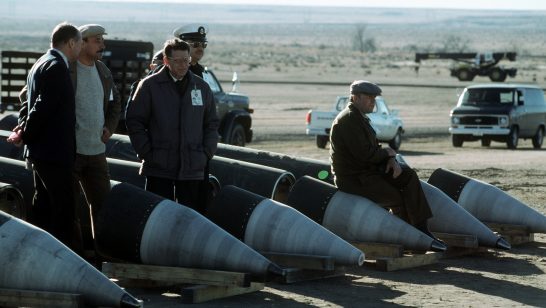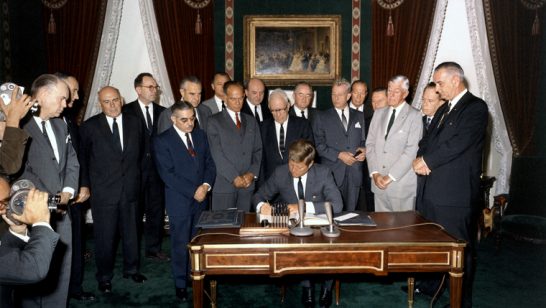
Next month, top leaders from over 50 countries will meet in The Hague, at the 2014 Nuclear Security Summit. After three such summits, the leaders’ fundamental goal remains to prevent nuclear terrorism by implementing effective security at all sites that store or process nuclear weapons or fissile materials, or which operate nuclear reactors.
Arguably, the threat of nuclear terrorism is much diminished. Al Qaeda, which avowed an interest in obtaining and using nuclear weapons, is weakened. Bin Laden is dead. Over the past two decades, enormous progress has been made in securing nuclear weapons and fissile materials. The Bratislava Initiative completed physical security upgrades at 148 Russian nuclear sites in 2008. Twenty-seven countries have eliminated all nuclear weapons-usable material from their soil, twelve since the Nuclear Security Summit process began.
A strengthened International Atomic Energy Agency issued new physical security recommendations in 2011, and since 2008, the World Institute for Nuclear Security has promoted the sharing and implementation of best practices in nuclear security.
In sum, our enemies are weaker and our defenses are stronger. Complacency, however, would be a grave, perhaps fatal error. Indeed, complacency is anathema to effective security.
There is much speculation about the gravity of the nuclear terrorism threat. In 2007, published estimates of the chances of terrorists detonating a nuclear weapon in a U.S. city over the next ten years ranged from one percent to 50 percent. There is little doubt, however, that if a sophisticated group obtained enough fissile material, it could set off a nuclear explosion. The key then is to deny terrorists access to such material.
How then are we doing in our efforts to secure fissile material from theft? Experience tells us not well. Indeed, we are failing.
In twenty known cases over the past twenty years, officials have seized plutonium or highly enriched uranium outside of authorized control. The most recent such cases were in 2003, 2006, 2010, and 2011. In the 2011 case, six people in Moldova were arrested with 4.4 grams of highly enriched uranium (HEU). The smugglers claimed to have access to 9 kilograms of HEU.
While none of these incidents involved enough material to fabricate a nuclear weapon, they are important for two reasons. First, in many instances and as with the Moldova case, the seized material was advertised as a sample of a larger quantity for sale. Material which, if it exists, authorities have never recovered. Second, the presence of fissile material outside of security measures is physical evidence of failure that might be recurring. In only one of the cases do we know the site where the material was stolen. We also do not know who took the material, how they got it off the site, or who they planned to sell it to. If we do not know which facility the material was taken from or the answers to the other relevant questions, how can we have any confidence that the problem has been corrected?
A second category of evidence on the nuclear terrorism threat is created by security near-misses. Two incidents in particular should raise serious questions about the effectiveness of measures to protect fissile material—not only at those sites, but around the world.
In 2007, at Pelindaba, South Africa, intruders launched two attacks within minutes of each other on a site housing hundreds of kilograms of HEU left over from the South African nuclear weapons program. Guards repelled one group, but a second penetrated an operations center. In the confusion, a plant employee was shot. Subsequent investigations revealed that the attackers likely acted with inside information. The South African government dismissed the incident as a bungled burglary (Pelindaba ironically means roughly “the conversation is closed” or “the affair is ended”). Moreover, there is no evidence that the intruders intended to take the HEU. Nonetheless, the fact that they got so close to enough HEU to make a dozen or more nuclear weapons is an important warning. Indeed, the South African government has reportedly taken steps to improve security at Pelindaba, but a further violation of protective measures was reported to its national nuclear regulator in June 2012.
In July 2012, four months to the day after President Obama returned form the Seoul Nuclear Security Summit, an 82-year-old nun and two senior citizen accomplices broke into the Y-12 National Security Complex, near Oak Ridge, Tennessee. The site houses the central U.S. repository for weapons-grade uranium. The intruders slowly hiked more than a mile through difficult terrain, taking over an hour to reach the Highly Enriched Uranium Materials Facility. There, they cut through three additional fences fitted with sophisticated sensors. They poured blood on, graffitied, and sledge-hammered the exterior of the HEU storage building. Guards inside the building mistakenly took the pounding as construction activity—at 4:30 a.m. When, eventually a guard was sent to investigate the matter, he had trouble finding the nun and her accomplices, let them roam around to collect their belongings after locating them, and mishandled his weapon.
Later investigations revealed deep failures in the security culture at Y-12—a facility once thought to be among the best run in the U.S. nuclear weapons infrastructure. Had the intruders been part of a terrorist cell with a well-armed follow-up group, the outcome could have been very different, especially if they had insider assistance. Worse, the incident apparently revealed systemic failure, beyond Y-12. The head of the National Nuclear Security Administration, Thomas D’Agostino, responded to an Inspector General report by calling the incident “a completely unacceptable breach of security and an important wake-up call for our entire complex.” Ominously, he warned that “We believe that this incident raises important questions about the security of Category I [weapons-grade] nuclear materials across the DOE [Department of Energy] complex.”
Both Pelindaba and Y-12 were thought by their governments to be secure. That confidence led to complacency. Complacency caused failure. In all likelihood this same dynamic is occurring in other states with nuclear weapons and material. There is no reason to assume that the security the cultures in South Africa and the United States are worse than they are in the rest of the world.
Leaders at the Hague Nuclear Security Summit will consider many excellent ideas about how to improve the regulation, management, and implementation of effective nuclear security. But leaders need to be motivated to take difficult steps—to change standard operating procedures, close unneeded facilities, and spend money on sustaining security measures. The first step is to recognize the hard truth of our experience over the past several years. Despite a lot of good work, we are failing at nuclear security.
*William Tobey is a senior fellow at the Harvard Kennedy School’s Belfer Center for Science and International Affairs. From 2006-2009, he was a deputy administrator of the U.S. National Nuclear Security Administration.
The opinions articulated above represent the views of the author(s), and do not necessarily reflect the position of the European Leadership Network or any of its members. The ELN’s aim is to encourage debates that will help develop Europe’s capacity to address the pressing foreign, defence, and security challenges of our time.



